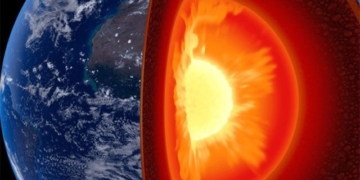The Earth was once a terrifying fireball with a deadly atmosphere filled with lethal carbon dioxide. But a mysterious force arose, transforming the planet into a breathable environment and burrowing deep into the Earth, hiding for billions of years.
As evidence suggests, just like the name of the first geological era – Hadean, which translates to Era of Fire – the Earth was once a challenging fireball to inhabit, with a sky covered in carbon dioxide clouds similar to that of Venus, according to Sci-Tech Daily.
However, it underwent a remarkable transformation, becoming increasingly breathable and cooler. Beyond the natural cooling of the planet, geological evidence indicates that Earth experienced a strange metamorphosis, during which lethal carbon dioxide was rapidly diminished.

The Earth has ended the “hellfire ball” phase with the help of mysterious “green wizard” rocks – (Photo: Simone Marchi, Southwest Research Institute)
Two geologists, Jun Korenaga and Yoshinori Miyazaki from Yale University, combined aspects of thermodynamics, fluid mechanics, and atmospheric physics to recreate a model of the Earth and concluded that the primordial planet was covered by a type of rock that no longer exists.
These rocks, rich in minerals known as pyroxene, could have a striking green color and were extremely rich in magnesium.
These magnesium-rich minerals reacted vigorously with carbon dioxide to form carbonates, playing a crucial role in sequestering carbon from the atmosphere.
As the molten Earth began to solidify, its warm and hydrated mantle—a 3,000-kilometer thick layer of the planet—also underwent a significant transformation, in conjunction with the “green wizard” rocks that repelled the dreaded carbon dioxide in just 160 million years.
“As an added bonus, these strange rocks would easily react with seawater to produce a large flow of hydrogen, which is essential for the creation of biological molecules,” Professor Korenaga added.
After this miraculous phase, this mysterious green rock followed the complex tectonic processes of the Earth and sank deep into the mantle, completing its mission.
This research was recently published in Nature.


















































